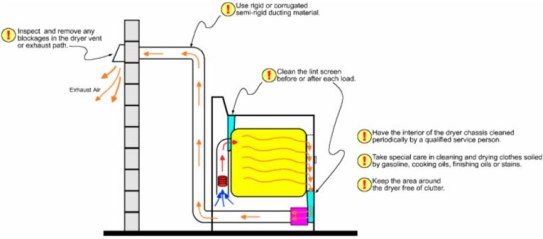Did you know overheated clothes dryers can cause fires?
Fires can occur when lint builds up in the dryer or in the exhaust duct. Lint can block the flow of air, cause excessive heat build-up, and result in a fire in some dryers.
The U.S. Consumer Product Safety Commission estimates that in 1998, clothes dryers were associated with 15,600 fires, which resulted in 20 deaths and 370 injuries.
Prevent Dryer Fires
- Clean the lint screen/filter before or after drying each load of clothes.
If clothing is still damp at the end of a typical drying cycle or drying requires longer times than normal, this may be a sign that the lint screen or the exhaust duct is blocked. - Clean the dryer vent and exhaust duct periodically.
Check the outside dryer vent while the dryer is operating to make sure exhaust air is escaping. If it is not, the vent or the exhaust duct may be blocked. To remove a blockage in the exhaust path, it may be necessary to disconnect the exhaust duct from the dryer. Remember to reconnect the ducting to the dryer and outside vent before using the dryer again. - Check the exhaust duct more often if you have a plastic, flexible duct.
This type of duct is more apt to trap lint than ducting without ridges. - Clean behind the dryer, where lint can build up.
Have a qualified service person clean the interior of the dryer chassis periodically to minimize the amount of lint accumulation. Keep the area around the dryer clean and free of clutter. - Replace plastic or foil, accordion-type ducting material with rigid or corrugated semi-rigid metal duct.
Most manufacturers specify the use of a rigid or corrugated semi-rigid metal duct, which provides maximum airflow. The flexible plastic or foil type duct can more easily trap lint and is more susceptible to kinks or crushing, which can greatly reduce the airflow. Closely follow manufacturers’ instructions for new installations. Most manufacturers that get their clothes dryers approved by Underwriters Laboratories specify the use of metal exhaust duct. If metal duct is not available at the retailer where the dryer was purchased, check other locations, such as hardware or builder supply stores. If you are having the dryer installed, insist upon metal duct unless the installer has verified that the manufacturer permits the use of plastic duct. - Take special care when drying clothes that have been soiled with volatile chemicals such as gasoline, cooking oils, cleaning agents, or finishing oils and stains.
If possible, wash the clothing more than once to minimize the amount of volatile chemicals on the clothes and, preferably, hang the clothes to dry. If using a dryer, use the lowest heat setting and a drying cycle that has a cool-down period at the end of the cycle. To prevent clothes from igniting after drying, do not leave the dried clothes in the dryer or piled in a laundry basket.

U.S. Consumer Product Safety Commission – CPSC Document #5502, Updated June 2003
